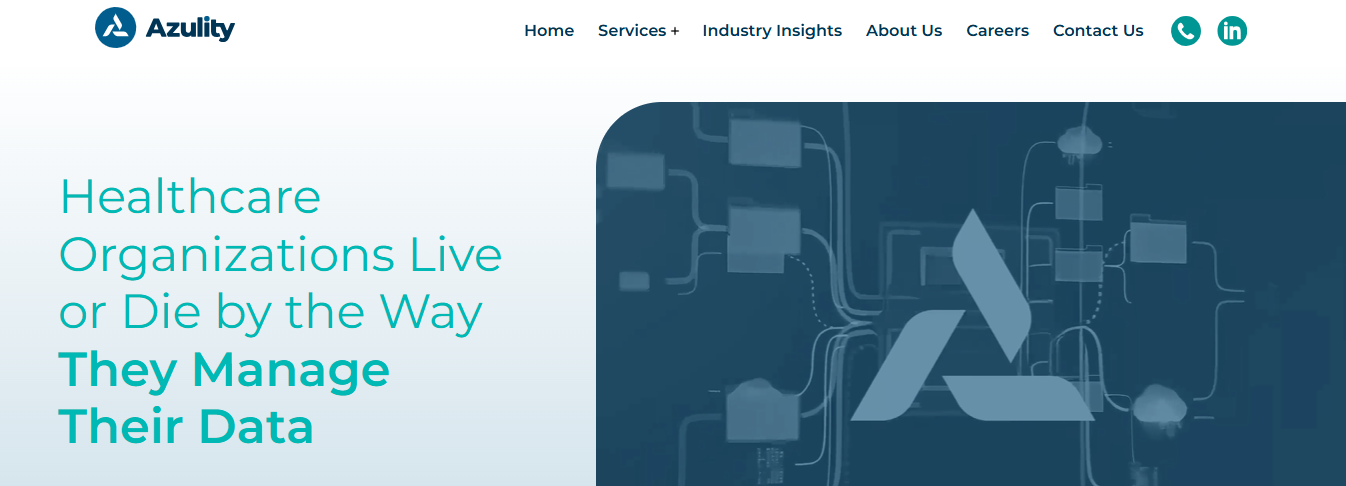Staffing Issues in Healthcare are one of the reasons healthcare organizations are under immense pressure to improve retention rates as they cope with chronic staffing issues. For instance, a facility may lose a critical staff member, such as a nurse, who has been working on a COVID-19 unit for over a year. Instead of having the necessary time to recover and adjust to the new normal, the organization quickly fills the vacancy with a traveler without prior knowledge of the unit. It will need extensive orientation before contributing to patient care.
Meanwhile, the facility’s patients and existing staff continue to suffer as the organization scrambles to regain operations. Articles that address employee retention in healthcare offer valuable insight to help organizations improve their internal staffing issues and avoid such scenarios. In this guide, we will discuss how to improve employee retention rates in healthcare and allow organizations with provider credentialing.
Azulity’s provider credentialing services can help healthcare organizations achieve their goals. Our services streamline the credentialing process. When an organization needs to bring in temporary or traveling staff to address a staffing crisis, it can work faster and reduce the impact on patient care.
Reasons for Low Employee Retention in Healthcare


The Aging Workforce Is Impacting Employee Retention in Healthcare
As healthcare workers reach retirement age, the workforce steadily shrinks in size. Statistics show that the average age of a registered physician is 51.7 years, while that of a registered nurse is 52 years. Many healthcare workers will likely retire in the next decade, resulting in the industry losing skilled and knowledgeable staff.
Implement effective succession strategies to ensure a sufficient number of experienced personnel. For instance, invest in entry-level training programs for a younger workforce. These education programs help your employees develop skills and competencies in the healthcare sector.
Quitting or Changing Careers
Healthcare workers endure severe stressors in their work environment, such as fatigue, long hours, and burnout. These factors negatively affect physical and mental health, driving healthcare workers to seek better career alternatives. Improving the working conditions of healthcare workers increases your employees’ satisfaction.
Strategies to try out include
- Ensuring adequate staffing levels
- Providing safe working facilities,
- Offering competitive salaries and bonuses,
- Allowing opportunities for career growth
Increasing Supply-and-Demand Issue
An ever-growing and aging population is increasing the demand for healthcare nationwide. Rising incidences of chronic illnesses put a strain on the healthcare system. The diversity of health workers who address these health conditions must catch up to the growing diversity of patients. Without appropriate interventions, there will be a global shortfall of 18 million healthcare workers.
Fortunately, untapped potential exists in leveraging technology to enhance healthcare delivery. You can use telemedicine to assist the physician in effectively monitoring the patient’s health status remotely. This trend allows for better management of chronic conditions that require long-term care, especially home care.
Insufficient Funding and Resources
Healthcare facilities sometimes face budget constraints and resource limitations. This limits the ability of the facility to adequately pay and equip staff, further amplifying healthcare retention issues. This insufficiency results in safety hazards, poor working conditions, and high stress among your workers. There’s only so much you can do about your finances. One way to meet your yearly budget goals is to outsource non-core functions.
6 Pillars of Employee Retention


1. Work Organization and Environment
The foundation of a good workplace is a well-structured, supportive, and appealing environment.
Key aspects include
- Clear roles and responsibilities so employees know what’s expected of them.
- Efficient workflows and processes that reduce frustration and allow employees to focus on meaningful tasks.
- Flexible work arrangements (like remote work or hybrid models) that accommodate personal needs and lifestyles.
- Safe and comfortable physical workspaces that promote health, collaboration, and productivity.
- Open communication channels so employees can provide feedback, share concerns, and feel heard.
A well-organized environment fosters a sense of stability, motivation, and purpose.
2. Health, Sport, and Leisure
Employee well-being is directly linked to job satisfaction and performance.
This pillar covers
- Mental health support, such as access to counseling or stress management workshops.
- Physical health initiatives, including gym memberships, sports events, or ergonomic office setups.
- Work-life balance support, like generous vacation policies, family leave, and manageable workloads.
- Team-building and leisure activities, such as retreats or social events, to foster camaraderie and reduce stress.
Supporting health and leisure signals that the company values employees beyond just their work output.
3. Personnel Development
People want to grow professionally and personally.
This pillar includes
- Training and learning opportunities such as workshops, courses, and certifications.
- Clear career paths and advancement opportunities to motivate employees to stay and grow within the organization.
- Mentorship programs that guide younger employees or newcomers.
- Personal development initiatives like language learning or financial literacy training.
Investing in development increases loyalty and improves the overall competency of your team.
4. Employer Branding
How your company is perceived—both internally and externally—matters.
This includes
- A clear mission and values that resonate with employees and align with their beliefs.
- Transparent communication about what the company stands for.
- Recognition as a great workplace, demonstrated through awards, reviews, and positive word of mouth.
- Social responsibility and sustainability practices that show the company’s commitment to broader goals.
A strong employer brand attracts the right talent and makes current employees proud to stay.
5. Corporate Culture and Communication
Culture is the glue that holds an organization together.
This pillar involves
- A respectful, inclusive, and diverse environment where everyone feels welcome and valued.
- Regular and honest communication, both top-down and bottom-up.
- Encouraging feedback and showing that it leads to real change.
- Fostering teamwork and collaboration through shared goals and group initiatives.
When people feel they belong and their voice matters, they’re more likely to stay engaged.
6. Perks and Benefits
Beyond salary, benefits play a significant role in retention.
This includes
- Comprehensive health insurance, retirement plans, and paid time off.
- Bonuses and profit-sharing to reward performance.
- Flexible benefits, like remote work stipends or child care assistance.
- Small perks like free snacks, commuter benefits, or wellness programs.
Tailoring benefits to your workforce’s needs shows appreciation and builds long-term loyalty.
Azulity specializes in healthcare master data management and provider credentialing services, bringing proven expertise in implementing healthcare data solutions and credentialing across the US. Our comprehensive platform ensures consistent patient, provider, location, and claims data synchronization across all systems and departments.
Key features include healthcare MDM, provider MDM, reference data management, credentialing, and provider enrollment. We serve healthcare technology leaders – from CIOs and CDOs to VPs of data platforms and credentialing – helping them eliminate the costly problems of fragmented data systems. Book a call to learn more about our healthcare master data management services today!
Related Reading
- Resource Allocation in Healthcare
- Healthcare Workforce Shortage Solutions
- How to Recruit Healthcare Professionals
How to Increase Employee Retention in Healthcare in 8 Ways


1. Use Azulity
Azulity focuses on improving healthcare staffing by tackling the costly problem of fragmented data systems. Their master data management (MDM) platform ensures healthcare organizations can locate, verify, and organize provider data accurately and quickly to improve staffing. By eliminating the delays caused by incomplete or inaccurate information, MDM solutions can help organizations accelerate onboarding and enhance the experience for new hires and their departments. Book a call with Azulity to learn more about their healthcare master data management services today!
2. Let’s Begin with the Basics of Retention: Hire the Right People in the First Place
Retention starts with recruitment and the ability to identify skilled and talented people likely to fit well into the organization’s culture. Depending on the position, it can cost healthcare providers anywhere from US$3,000 to US$7,000 and take a few months to nearly a year to fill a vacant position. Those costs don’t factor in the toll on existing staff called on to provide interim coverage. It pays to find people who will produce at a high level and stay for the long term. AI-based HR systems can help organizations identify those people.
3. Onboard Your People With Purpose
Across all industries, nearly a third of new hires quit within the first six months. Top reasons include feeling neglected, overwhelmed, and underappreciated—feelings employers can head off with structured onboarding programs that give new hires the confidence to succeed out of the gate. At a minimum, onboarding must make it simple for new hires to fill out forms and get trained on systems, policies, and procedures, which is even more critical in the highly regulated healthcare industry.
A modern human capital management (HCM) system’s interactive digital assistant can help new hires through the basics. Meanwhile, healthcare organizations must apply a personal touch to help new hires quickly build lasting relationships. This includes assigning each new hire a mentor early on, organizing a tour of the premises and a team lunch on their first day, introducing new employees to colleagues and senior leaders, formally announcing each new hire and providing some fun background information in an organization wide email, and regularly asking recent hires for feedback on early challenges and celebrating successes.
4. Offer Some Scheduling Flexibility
Forcing healthcare practitioners to log long hours with insufficient help is a recipe for burning them out and losing them to competitors or other professions. Some doctors, nurses, and supporting staff like a fixed, predictable schedule, but flexibility and variety in when and where they work are welcome for others. Everyone wants a healthy work-life balance. Some hospital groups offer nontraditional schedules to their practitioners and support staff, including staggered start times and overlapping shifts to help compensate for shortages.
They even allow some people to set their schedules—an option that appeals to younger professionals, those with family responsibilities, and those wanting overtime pay. Some groups have built internal staffing agencies to share practitioners across locations. Novant Health, for example, runs what it calls a “float pool” of a couple of hundred nurses who travel among the system’s 15 hospitals and 360 physician practices across the Carolinas.
A major hospital group in India allows radiology, lab, and other specialists to work remotely while creating a hybrid model for others—a model that’s also attractive to young practitioners and those with families. Here, too, technology can play a significant role. The popularity of Zoom and other video conferencing software makes it easier for practitioners and patients to discuss select health matters virtually; it’s also more cost-effective for hospitals and practices and safer for caregivers and patients when dealing with contagious illnesses.
Some hospital systems are exploring “virtual nursing” to allow remote staff to handle more patient admission workload. In this model, an on-premises floor nurse can physically assess the patient, and a remote nurse can update data on allergies, medications, and medical history. Upon the patient’s discharge, the remote nurse can review orders and documentation, deliver education, and check if a pharmacy is documented.
Meanwhile, AI-based workforce-planning applications can help managers predict surges in patient demand and set practitioner schedules accordingly. Northwell Health, one of the largest health systems in New York State, used a dashboard on its cloud HCM system to help its chief nursing officers stay abreast of patient inflows, staff recruitment, and resource requirements during the COVID-19 pandemic.
5. Build a More Engaged Professional Workforce
When HR leaders talk about improving employee engagement, they generally focus on steps employers can take to connect with their people more personally and create a sense of loyalty. Alternatively, they talk about improving the employee experience. Strategies to foster and manage employer-employee connections include providing practitioners and support staff personalized career guidance based on their unique backgrounds and circumstances.
Healthcare employers are also conducting regular employee surveys and encouraging feedback on ways to improve the organization. They’re also connecting caregivers with mental health services—as well as with communities of their peers for advice and support—to avoid burnout. The goal is to create a culture where employees engage more regularly with their peers and management, building appreciation and a sense of belonging.
6. Stay Current on Pay and Other Forms of Compensation
The healthcare profession may be a higher calling for most practitioners. However, everyone still wants to be paid what they’re worth, especially given the rigors of the field and the competitive market. Provider HR organizations must use external benchmarking data to adjust their compensation plans for medical staffers and contractors.
Complicating matters for the healthcare industry is that costs continue to rise for systems, supplies, malpractice insurance, heating, electricity, and other goods and services. At the same time, the workforce shortage puts upward pressure on salaries and wages. For example, the price of traveling nurse services tripled during the pandemic and remains relatively high.
There’s only so much money to go around, so healthcare providers must get creative with compensating their people. Financial incentives—in addition to competitive salaries and benefits—include signing and merit bonuses, tuition reimbursements, subsidies for childcare, and student loan repayment programs. Increasingly popular are relative value unit (RVU) plans that compensate physicians, in part, based on their productivity and quality of service.
7. Hire Enough People
Ultimately, the shortage of healthcare workers creates a vicious circle: Not having enough doctors, nurses, and other practitioners leads to overwork, stress, and burnout, which causes people to leave their professions, further worsening the worker shortage. Unfortunately, there are no easy solutions. At the hospital and medical practice level, employers must form partnerships with high schools, universities, training programs, and other institutions to develop and recruit workers at different professional levels.
In the long term, a cooperative public-private sector healthcare Marshall Plan will be necessary to educate, train, and make available sufficient numbers of qualified professionals. The American Hospital Association has called on US policymakers to lift the cap on Medicare-funded physician residencies, boost support for nursing schools and faculty, and expedite visas for highly trained foreign healthcare workers, among other measures.
8. Ease the Paperwork Burden on Care Providers
Doctors and nurses are burning out and leaving the profession because they’re overworked and frustrated with the administrative tasks they must complete each day. This paperwork burden has spread more widely across the industry in recent years. In 2018, 70% of physicians said they spent more than 10 hours per week on paperwork and administrative tasks, up from 57% in 2017. 2014, only one-third of physicians spent 10 hours a week on such tasks.
Importance of Hiring the Right People in Healthcare


Recruiting Healthcare Professionals: Why It Matters
Recruiting healthcare professionals is essential to ensuring quality patient care. The caliber of professionals delivering care directly impacts the quality of that care.
By implementing robust recruitment strategies, healthcare organizations can
- Attract highly skilled professionals
- Ensure a diverse workforce that reflects the patient population,
- Bring in fresh perspectives and innovative approaches to care.
- When healthcare facilities prioritize recruitment, they invest in better patient outcomes and satisfaction.
Attracting Top Talent
A healthcare organization’s reputation is closely tied to its ability to attract and retain top talent. Recruitment strategies prioritizing hiring skilled and experienced professionals contribute to a positive reputation within the industry. Word-of-mouth recommendations, positive reviews, and professional accolades all play a role in attracting high-caliber candidates. A strong reputation can also make it easier to recruit for hard-to-fill positions and attract candidates from competitive markets.
Addressing Staff Shortages & Burnout
The healthcare industry is notorious for staff shortages and high burnout rates, particularly in specialized fields such as nursing, radiology, and surgical care.
Effective recruitment strategies can mitigate these issues by
- Ensuring adequate staffing levels,
- Reducing workload on existing staff,
- Introducing new team members with fresh energy and ideas.
By continuously bringing in new talent, healthcare organizations can create more balanced and sustainable work environments, increase job satisfaction, and reduce turnover. This involves anticipating future staffing needs and seeking qualified candidates before vacancies become critical. Building a pipeline of potential hires and maintaining relationships with educational institutions can help healthcare organizations avoid staffing challenges.
Flexible Staffing Solutions
In addition to traditional recruitment methods, healthcare organizations can benefit from flexible staffing solutions such as temporary staffing, part-time roles, and telehealth positions. Healthcare recruitment strategies incorporating these options can help organizations adapt to fluctuating patient volumes and changing healthcare demands. This flexibility ensures patient care isn’t compromised during peak times or unexpected staff shortages.
Keeping Pace with Technological Advancements
Healthcare technology is advancing at breakneck speed. From AI-assisted diagnostics to telemedicine, the industry requires professionals who aren’t only medically competent and technologically savvy.
Recruitment strategies should include assessing candidates’ proficiency with technology and their ability to adapt to new advancements. Furthermore, ongoing training and development programs can help existing staff stay current with the latest technological trends, ensuring the organization remains at the forefront of healthcare innovation.
Embracing Digital Recruitment Tools
As the healthcare industry continually evolves with technological advancements, recruitment strategies must keep pace. Digital recruitment tools, such as applicant tracking systems (ATS), social media platforms, and online job boards, have become integral to modern recruitment processes. These tools streamline the hiring process, making it more efficient and effective. By embracing technology, healthcare organizations can reach a wider pool of candidates and make data-driven hiring decisions.
Cost-Effectiveness & Resource Optimization
While investing in recruitment might seem costly upfront, it’s a strategy that pays dividends in the long run.
Effective recruitment can lead to
- Reduced turnover costs
- Lower training expenses for new hires
- Improved operational efficiency
By bringing in the right people, healthcare organizations can optimize resources and reduce the financial burden of constant hiring and training cycles.
Building a Positive Work Culture
Effective recruitment strategies build a positive work culture, essential for employee satisfaction and patient care. By hiring individuals who align with the organization’s values and mission, healthcare facilities can create a cohesive and supportive work environment. A positive work culture enhances employee morale, leading to better collaboration, improved patient care, and a lower turnover rate.
Adapting to Changing Healthcare Models
The healthcare industry is shifting toward value-based models, emphasizing preventive care and patient outcomes. This transition requires a workforce that’s adaptable, patient-centered, and focused on holistic health. Effective recruitment strategies help healthcare organizations identify and attract professionals who can thrive in these new care delivery models.
Meeting Regulatory & Compliance Requirements
Healthcare is a highly regulated field with strict staffing ratios, qualifications, and continuing education requirements.
Strategic recruitment ensures healthcare organizations can
- Meet and exceed regulatory standards
- Maintain proper staffing levels across all departments
- Ensure all staff members have the necessary credentials and qualifications
By prioritizing compliance in the recruitment process, healthcare facilities can avoid legal issues and maintain their reputation for quality and safety.
Fostering Innovation & Research
Many healthcare organizations aren’t just care providers but also research and innovation centers.
Effective recruitment strategies can attract
- Researchers and academics
- Professionals with a passion for innovation
- Individuals with diverse backgrounds and perspectives
By bringing together diverse groups of talented professionals, healthcare organizations can foster environments of continuous learning and advancement, contributing to the overall progress of medical science.
Addressing Specialized Skills Gaps
Healthcare is a field of specialization, and recruitment strategies are crucial in addressing skills gaps in niche areas. Whether it’s finding neurosurgeons for an expanding brain center or genetic counselors for a new personalized medicine program, targeted recruitment efforts ensure healthcare organizations can meet specific needs and expand their service offerings.
Preparing for Future Challenges
The healthcare landscape is constantly evolving, with new challenges emerging regularly. From global pandemics to the rise of chronic diseases, healthcare organizations need to be prepared.
Strategic recruitment allows these organizations to
- Build a workforce with diverse skill sets,
- Create adaptable teams that can respond to crises, and
- Develop leadership pipelines for future organizational growth.
By thinking ahead in their recruitment efforts, healthcare organizations can tackle future challenges head-on.
Related Reading
Book a Call to Learn More About Our Provider Credentialing Services


When the healthcare industry experiences high employee turnover, it affects the quality of patient care. Research shows that for every 1% increase in nursing turnover, patient mortality rates increase by 7%. High turnover rates among nurses and other healthcare staff lead to a “revolving door” effect that compromises the continuity of care. As experienced clinicians leave, they take valuable knowledge and skills directly impacting patient outcomes. Furthermore, organizations with high turnover rates tend to have lower staff morale, negatively affecting patient care.
The Cost of Healthcare Turnover is Too High
Employee turnover is costly in healthcare. According to the Nursing Solutions, Inc. report, the average cost of replacing a bedside nurse is over $50,000. This number increases when factoring in lost productivity and the impact of turnover on patient care. The costs to replace other healthcare roles, such as allied health professionals and physicians, can be even higher. Organizations must prioritize employee retention to keep staff, ensure a stable workforce, and maintain their financial health.
Understanding Why Healthcare Employees Leave
To effectively improve employee retention in healthcare, organizations must first understand why staff leave. While there are many reasons healthcare employees become dissatisfied with their jobs, some of the most common causes of turnover include:
- Poor compensation
- Insufficient staffing and excessive workloads
- Limited career growth opportunities
- Inflexible schedules or lack of work-life balance
- Poor management and leadership
- Lack of employee recognition
- Unsafe work environments
- Limited access to resources and support
Employees are often unhappy for various reasons, so an effective retention strategy must address their concerns.
Strategies to Improve Employee Retention in Healthcare
Improving employee retention in healthcare requires a multi-faceted approach. Some effective strategies organizations can employ to keep staff include:
Prioritize employee well-being
Taking care of healthcare workers’ mental health and well-being directly impacts patient care. Organizations can improve employees’ job satisfaction and morale by supporting them through difficult times, such as those experienced during the COVID-19 pandemic.
Implement succession planning
Succession planning helps organizations identify and develop internal candidates to fill critical roles. By prioritizing internal promotions over external hires, healthcare organizations can improve employee retention and ensure continuity of care for patients.
Foster a culture of diversity and inclusion.
Healthcare organizations must create a culture that values diversity and fosters an environment of inclusion. Prioritizing D and I will improve employee satisfaction and create a more effective workforce better equipped to meet the needs of diverse patient populations.
Use data to drive decision making.
Healthcare organizations collect vast amounts of data, yet many fail to use this information to improve operations and employee satisfaction. Organizations can identify existing problems and develop targeted solutions to improve retention by analyzing workforce data, such as turnover and engagement scores.
Offer competitive compensation
One of the most effective ways to improve employee retention in healthcare is to offer competitive pay and benefits. Organizations must regularly assess their compensation packages to meet or exceed industry standards.
Provide opportunities for career advancement.
Creating clear pathways for career advancement will improve employee morale and retention. Organizations can support employees’ professional goals by providing mentorship opportunities, offering continuing education, and promoting from within.
Foster a positive work environment.
Improving employee morale is essential to retaining healthcare staff. Organizations can boost morale by creating a positive work environment where employees feel valued and supported. This includes recognizing individual and team achievements, promoting a safety culture, and ensuring adequate staffing to prevent burnout.
Improve onboarding and training.
A comprehensive onboarding and training program will help new hires feel more confident in their roles and improve employee retention in healthcare. Organizations can use these programs to instill culture, promote diversity and inclusion, and ensure staff have the resources and support they need to succeed.
Utilize technology to reduce burnout.
Burnout is a leading cause of turnover in healthcare. Organizations can improve employee retention by identifying the causes of burnout in their facilities and taking steps to alleviate the problem. Implementing technology and automation to reduce repetitive tasks and streamline workflows can help alleviate employee stress and improve job satisfaction.
Develop employee retention plans.
Finally, healthcare organizations should develop employee retention plans to improve their strategies for keeping staff. These plans should include actionable steps for improving retention and measurable goals to track progress over time.
